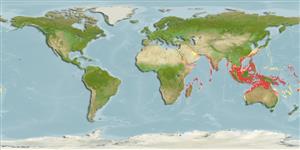Teleostei (teleosts) >
Pleuronectiformes (Flatfishes) >
Citharidae (Citharids)
Etymology: Brachypleura: Greek, brachys, eia = short + Greek, pleura = side, rib (Ref. 45335).
More on author: Günther.
Environment: milieu / climate zone / depth range / distribution range
Ecology
Marine; demersal; depth range 18 - 92 m (Ref. 11441). Tropical
Indo-West Pacific: Persian Gulf through the eastern Indian Ocean to the East Indies.
Size / Weight / Age
Maturity: Lm ? range ? - ? cm
Max length : 14.0 cm TL male/unsexed; (Ref. 9797)
Dorsal
spines
(total): 0;
Dorsal
soft rays
(total): 65-77;
Anal
spines: 0;
Anal
soft rays: 41 - 50. Ground color yellowish or yellowish brown; dorsal, anal and caudal fins paler than body with dark spots. Blind side whitish. Some anterior dorsal fin rays elongated in males, not in females, all rays except a few at posterior end of fin unbranched. Pectoral fin on eyed side with 11-13 rays, on blind side with 10-13 rays. Caudal fin with 13-14 branched rays and rounded margin.
Inhabits sand and mud bottoms (Ref. 9797). Frequently collected in areas near river mouths (Ref. 9797). Feeds on bottom-living animals (Ref. 9797). Mostly used in making fish meal but is also marketed fresh (Ref. 9797).
Life cycle and mating behavior
Maturity | Reproduction | Spawning | Eggs | Fecundity | Larvae
Kuronuma, K. and Y. Abe, 1986. Fishes of the Arabian Gulf. Kuwait Institute for Scientific Research, State of Kuwait, 356 p. (Ref. 5999)
IUCN Red List Status (Ref. 130435)
Threat to humans
Harmless
Human uses
Fisheries: minor commercial
More information
Common namesSynonymsMetabolismPredatorsEcotoxicologyReproductionMaturitySpawningSpawning aggregationFecundityEggsEgg development
ReferencesAquacultureAquaculture profileStrainsGeneticsElectrophoresesHeritabilityDiseasesProcessingNutrientsMass conversion
Tools
Special reports
Download XML
Internet sources
Estimates based on models
Preferred temperature (Ref.
123201): 23.7 - 28.6, mean 27.5 °C (based on 661 cells).
Phylogenetic diversity index (Ref.
82804): PD
50 = 1.0156 [Uniqueness, from 0.5 = low to 2.0 = high].
Bayesian length-weight: a=0.01122 (0.00514 - 0.02450), b=3.04 (2.87 - 3.21), in cm total length, based on all LWR estimates for this body shape (Ref.
93245).
Trophic level (Ref.
69278): 3.5 ±0.37 se; based on food items.
Resilience (Ref.
120179): High, minimum population doubling time less than 15 months (Preliminary K or Fecundity.).
Fishing Vulnerability (Ref.
59153): Low vulnerability (10 of 100).
